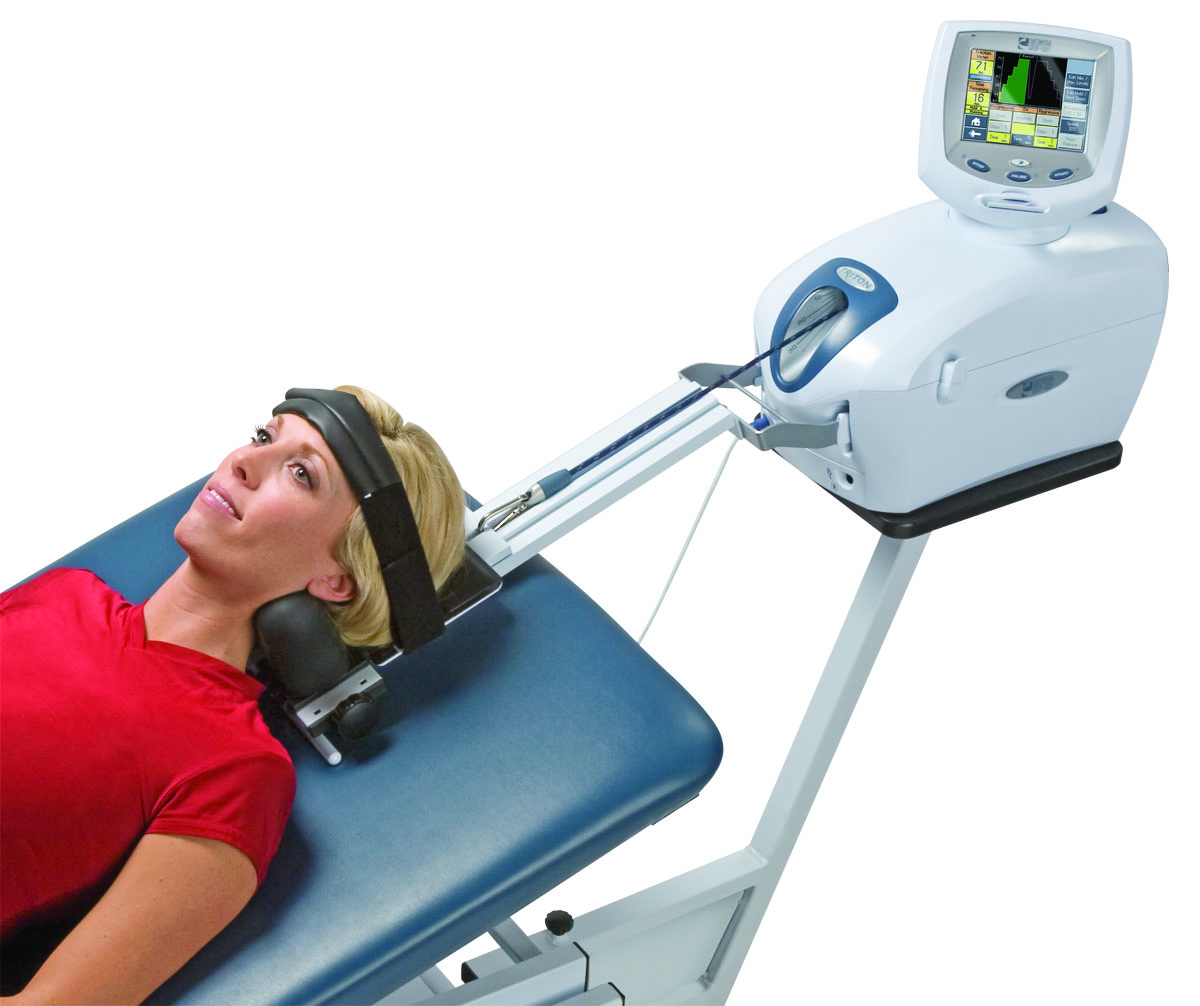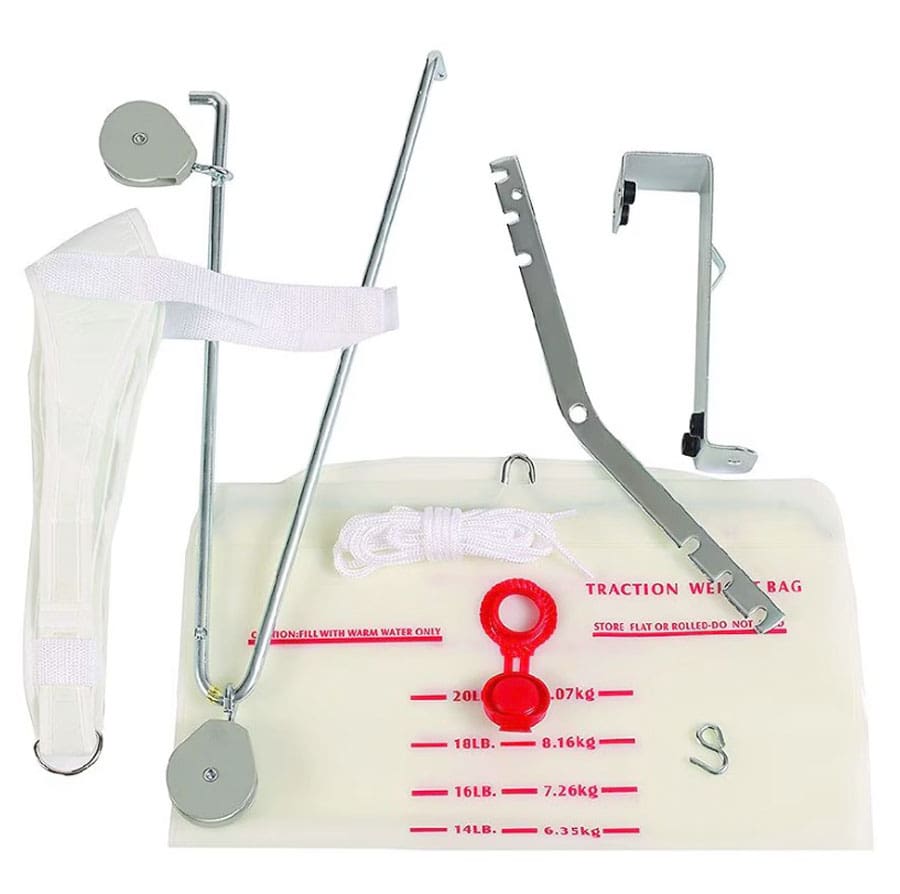Can using a self-care traction device help and be a cost-effective method of providing cervical relief at home for individuals who have neck pain?

Contents
Neck Pain Traction Device
Neck Pain Traction Device: Individuals with neck or arm pain caused by neck/cervical radiculopathy may benefit from physical therapy to manage their condition. (Alshami, A. M., and Bamhair, D. A. 2021) Physical therapy can improve neck mobility, restore function, and decrease pain.
Traction
A physical therapist may use various treatments and modalities to treat the individual’s condition. Cervical traction is one treatment to help relieve neck pain and can help:
- Stretch the muscles and soft tissues in the neck.
- Separate and open up the disc and joint spaces.
- Decrease pain in the neck and arms by relieving pressure on nerves from the cervical spine. (Madson, T. J., and Hollman, J. H. 2017)
There are different neck traction techniques. The therapist may use a mechanical traction device that requires the individual to strap their head and neck to a machine that gently pulls the neck, providing relief. (Romeo, A. et al., 2018) The physical therapist may also use manual traction with their hands to help the process. This type allows the therapist to easily adjust the amount of traction force and the direction of the pull on the neck. (Romeo, A. et al., 2018)
Home Traction Devices
Cervical traction that works for individuals at the clinic may also benefit from using a traction device at home to maintain their gains. Over-the-door cervical traction may be an effective, safe, and simple way to administer neck traction in the comfort of one’s home to help decrease pain. (Fritz, J. M. et al., 2014) Medical supply stores and pharmacies carry over-the-door traction devices, which can also be found online. If finding an over-the-door traction unit is difficult, the therapy clinic can help order one from a medical supplier.
Setting Up The Device
Before using a neck pain traction device, consult a physical therapist or doctor to ensure neck traction is safe and on usage. Over-the-door traction units may be built differently but comprise the main parts:
- A hook-and-pulley apparatus that hangs over the door.
- A nylon cord that’s fed through the pulley.
- A weight that could be a water bag that hangs on the end of the cord to provide traction force.
- A harness to wear on your head.
 The traction unit must be hung over a door secured to the top and closed.
The traction unit must be hung over a door secured to the top and closed.- It is recommended that the door be a closet door so no one will open it while using the device.
- If a closet door is not available, be sure to lock the door so that no one can open it while attached to the device.
- A small hook with a pulley attached to it hangs on the door.
- The harness attaches to the end of the nylon cord opposite the weighted water bag.
- The harness goes on the head, and the chin strap should fit snugly under the chin and be secured by the hook-and-loop fasteners.
- The two straps on either side of your head should be hooked to the end of the nylon cord, which is fed through the pulley system.
- After strapping on the head harness, fill the water bag using the markings on the bag to indicate its weight and hang it on one end of the cord.
- Fill the bag until the water reaches the desired mark, usually 8–15 pounds.
- After filling the water bag, sit in a chair facing the door and hang the bag on the other end of the cord not attached to the head harness.
- Do not drop the bag; this could cause a sudden forceful traction motion on your neck.
How Long to Use
Individuals should generally use the traction device for about 15 to 20 minutes each session and can perform several sessions per day. (American Physical Therapy Association. 2020) While using the over-the-door traction device, there should be a gentle pulling sensation in the neck, relieving the neck pain, and if there is arm pain or tingling, it should also decrease. Traction does not replace neck exercises or postural correction in treating neck pain. Be sure to follow the therapist’s prescribed exercises. Active engagement is essential to treating and preventing neck pain from returning. If the pain increases while using the traction device, stop using it and consult a physical therapist or doctor. Ask a physical therapist or other neuromusculoskeletal medical professional if self-care traction is appropriate for specific conditions.
Injury Medical Chiropractic and Functional Medicine Clinic works with primary healthcare providers and specialists to develop an optimal health and wellness solution that helps individuals return to normal. Our providers create personalized care plans for each patient, including Functional Medicine, Acupuncture, Electro-Acupuncture, and Sports Medicine principles through an integrated approach to treat injuries and chronic pain syndromes to improve ability through flexibility, mobility, and agility programs to relieve pain. If other treatment is needed, Dr. Jimenez has teamed up with top surgeons, clinical specialists, medical researchers, and rehabilitation providers to provide the most effective treatments.
Neck Injuries
References
Alshami, A. M., & Bamhair, D. A. (2021). Effect of manual therapy with exercise in patients with chronic cervical radiculopathy: a randomized clinical trial. Trials, 22(1), 716. https://doi.org/10.1186/s13063-021-05690-y
Madson, T. J., & Hollman, J. H. (2017). Cervical Traction for Managing Neck Pain: A Survey of Physical Therapists in the United States. The Journal of orthopaedic and sports physical therapy, 47(3), 200–208. https://doi.org/10.2519/jospt.2017.6914
Romeo, A., Vanti, C., Boldrini, V., Ruggeri, M., Guccione, A. A., Pillastrini, P., & Bertozzi, L. (2018). Cervical Radiculopathy: Effectiveness of Adding Traction to Physical Therapy-A Systematic Review and Meta-Analysis of Randomized Controlled Trials. Physical therapy, 98(4), 231–242. https://doi.org/10.1093/physth/pzy001
Fritz, J. M., Thackeray, A., Brennan, G. P., & Childs, J. D. (2014). Exercise only, exercise with mechanical traction, or exercise with over-door traction for patients with cervical radiculopathy, with or without consideration of status on a previously described subgrouping rule: a randomized clinical trial. The Journal of orthopaedic and sports physical therapy, 44(2), 45–57. https://doi.org/10.2519/jospt.2014.5065
American Physical Therapy Association. (2020). Physical therapy guide to cervical radiculopathy. https://www.choosept.com/guide/physical-therapy-guide-cervical-radiculopathy
Professional Scope of Practice *
The information on "Neck Pain Traction Device: Managing Neck and Arm Pain" is not intended to replace a one-on-one relationship with a qualified health care professional or licensed physician and is not medical advice. We encourage you to make healthcare decisions based on your research and partnership with a qualified healthcare professional.
Blog Information & Scope Discussions
Welcome to the wellness blog of El Paso Back Clinic, where Dr. Alex Jimenez, DC, FNP-C, a board-certified Family Practice Nurse Practitioner (FNP-C) and Chiropractor (DC), presents insights on how our team is dedicated to holistic healing and personalized care. Our practice aligns with evidence-based treatment protocols inspired by integrative medicine principles, similar to those found on dralexjimenez.com, focusing on restoring health naturally for patients of all ages.
Our areas of chiropractic practice include Wellness & Nutrition, Chronic Pain, Personal Injury, Auto Accident Care, Work Injuries, Back Injury, Low Back Pain, Neck Pain, Migraine Headaches, Sports Injuries, Severe Sciatica, Scoliosis, Complex Herniated Discs, Fibromyalgia, Chronic Pain, Complex Injuries, Stress Management, Functional Medicine Treatments, and in-scope care protocols.
Our information scope is limited to chiropractic, musculoskeletal, physical medicine, wellness, contributing etiological viscerosomatic disturbances within clinical presentations, associated somato-visceral reflex clinical dynamics, subluxation complexes, sensitive health issues, and functional medicine articles, topics, and discussions.
We provide and present clinical collaboration with specialists from various disciplines. Each specialist is governed by their professional scope of practice and their jurisdiction of licensure. We use functional health & wellness protocols to treat and support care for the injuries or disorders of the musculoskeletal system.
Our videos, posts, topics, subjects, and insights cover clinical matters, issues, and topics that relate to and directly or indirectly support our clinical scope of practice.*
Our office has reasonably attempted to provide supportive citations and has identified the relevant research studies or studies supporting our posts. We provide copies of supporting research studies available to regulatory boards and the public upon request.
We understand that we cover matters that require an additional explanation of how they may assist in a particular care plan or treatment protocol; therefore, to discuss the subject matter above further, please feel free to ask Dr. Alex Jimenez, DC, APRN, FNP-BC, or contact us at 915-850-0900.
We are here to help you and your family.
Blessings
Dr. Alex Jimenez, DC, MSACP, APRN, FNP-BC*, CCST, IFMCP, CFMP, ATN
email: coach@elpasofunctionalmedicine.com
Licensed as a Doctor of Chiropractic (DC) in Texas & New Mexico*
Texas DC License # TX5807
New Mexico DC License # NM-DC2182
Licensed as a Registered Nurse (RN*) in Texas & Multistate
Texas RN License # 1191402
ANCC FNP-BC: Board Certified Nurse Practitioner*
Compact Status: Multi-State License: Authorized to Practice in 40 States*
Graduate with Honors: ICHS: MSN-FNP (Family Nurse Practitioner Program)
Degree Granted. Master's in Family Practice MSN Diploma (Cum Laude)
Dr. Alex Jimenez, DC, APRN, FNP-BC*, CFMP, IFMCP, ATN, CCST
My Digital Business Card








